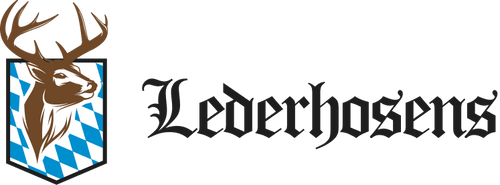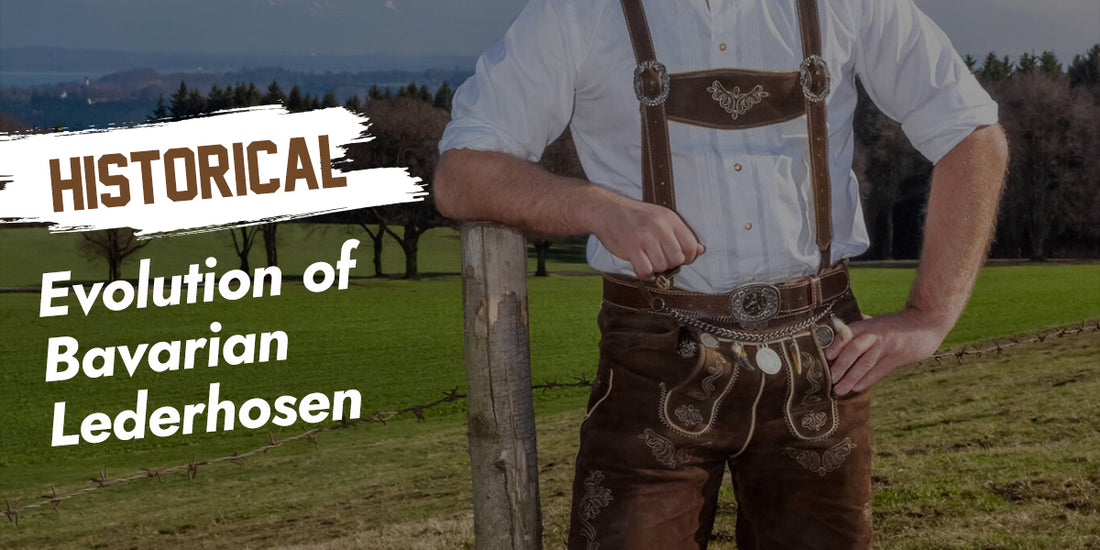More than just leather breeches, let’s get into details of the traditional Oktoberfest Lederhosen.
Oktoberfest has carried authentic German traditions for more than two centuries, and one thing that has been there since the beginning is Lederhosen. An average of six million people attend the world’s largest beer fest annually. Almost every local wears Lederhosen, and a majority of men among international visitors wear the Trachten Lederhose, paying homage to Bavarian culture. Women Lederhosen are also gaining popularity, while Dirndl remains the official feminine dress for the Wiesn.
Every detail of an authentic Lederhosen reflects the Bavarian roots, and the unmatched durability, smoothness, and versatility make it irreplaceable. Modern Lederhosen features intricate embroidery designs and stitching to match the public appeal, while the originality is kept alive in the details.
The Origin of Bavarian Lederhosen
The Bavarian and Austrian Alpine regions have harsh, rainy weather conditions year-round. In the 1700s, the farmers and peasants who worked in these conditions adopted leather-made breeches for protection against the weather. Copying the style of French breeches made of a lighter material, the Bavarians used cowhide and goatskin to make more durable and long-lasting versions. These breeches were transformed into trousers reaching knee-length or slightly below the knee and named Lederhosen (Leather Breeches).
These new leather trousers protected working-class men from the challenging weather conditions and allowed easy movement and long-term wear. Cowhide, Goatskin, and Boarhide were affordable yet strong, durable, and versatile materials for making Lederhosen.
Lederhosen Becomes a Fashion Trend
Lederhosen got the first notable impression at the very first Oktoberfest, which was the occasion of a royal marriage in 1810. The Bavarian Crown Prince Ludwig married Princess Therese von Sachsen, and the whole town was invited to the celebrations that went on for five days at the Theresienwiese grounds(named after the bride by King Max I).
The celebrations included fun rides, delicious foods, assembled parades, and a conclusive horse race that took the flowers. Most local attendees who enjoyed the celebrations were wearing Lederhosen and Bundhosen, which caught the eye of the elite. The upper class slowly started to adopt Lederhosen as they found it a decent wear for activities like horse riding and hunting. The trend grew and became a notable fashion in Bavaria. Workers kept wearing Lederhosen made from cowhide and goatskin for their work, and the elites used the much more premium deerskin to create even more robust, durable, and eye-catching Lederhosen.
Fun Fact: One of the significant reasons Lederhosen is worn at Oktoberfest is that it doesn't get stains if beer is spilled.
From Downfall of Lederhose to Becoming the Official Oktoberfest Outfit
In the 1870s, jeans were invented and quickly gained worldwide popularity. They were lightweight, soft on the body, and more fashionable. Jeans became a fashion mark among the younger generation and quickly dethroned Lederhosen. Jeans provided all the features of the men Bavarian Lederhosen at a lesser cost and with better visual appeal.
Efforts to Preserve the Bavarian Lederhosen
Although Lederhosen was still prevalent in the Eastern Alps, its everyday use declined on the outer edges of the mountain range. A school teacher from the Upper Bavarian town of Bayrischzell and his students decided to preserve the alpine Lederhosen tradition. Joseph Vogl created the Association for the Preservation of the National Costume in the Leitzach Valley and Bayrischzell in 1883 to preserve this alpine tradition. This association became a model for other preservation clubs known as Trachtenverein, which extended across the Eastern Alps from Munich to Salzburg and Vienna.
The upper class highly supported efforts to preserve traditional clothing and promote a national Bavarian identity. King Ludwig II endorsed the creation of Trachtenverein, and King Ludwig III wore Lederhosen on trips to the Alps to show his support for their preservation.
The great support and efforts paid off In 1887, as Lederhosen and Dirndl were officially declared the Oktoberfest wear for men and women, respectively.
Info: Since Lederhosen is made from top-quality, well-processed leather, it keeps the features of authentic leather. It can keep your body warm in cold temperatures and cold in the hotter days.
A Detailed Look Into Lederhosen: Ideal Materials, Colors, Lengths, and Pairing
Who thought that a workwear outfit for alpine peasants would become the symbol of Bavarian culture? Lederhosen has received a notable boost since becoming the official Oktoberfest clothing for men. With designers and manufacturers adding a modern touch, Lederhosen is no longer limited to Oktoberfest. They are now a fashion outfit worn at night parties, hiking trips, and casual evenings.
Fun Fact: The "drop fronts" of the Lederhosen serve a practical purpose. It allows the wearer to relieve themselves outdoors without removing the entire garment.
Many questions still surround the Bavarian leather breeches. Let's address each one by one:
What is Bundhosen? What Materials are Lederhosen and Bundhosen Made From?
Bundhosen is the more extended version of Lederhosen. They reach below the knees and were worn only on special occasions in the 1700s. They have grown in popularity recently as part of modern-day fashion. Every other component, including material, stitching, and embroidery, is the same for Lederhosen and Bundhosen.
Lederhosen is made with all sorts of leather, including deerskin, cowhide, goatskin, and boarhide. While all these leathers have a strong profile, deerskin tops the quality scale. Crafted with a smooth suede finish, Buckskin lederhosen is the most premium leather breeches and can last for generations without any wear and tear. Deerskin is also easy to color, primarily available in variations of brown and black. However, with premium functionality comes premium prices, which not everyone can afford.
Today, Lederhosen is often made with blends of cowhide and other materials, such as denim or cotton. This combination creates a stylish look that appeals to those who prefer a more relaxed or versatile option.
Fun Fact: Most of the leather used to manufacture millions of Lederhosen each year for Oktoberfest is sourced from Pakistan and New Zealand and the largest factories that make this Lederhosen are located in Sri Lanka, India, and Hungary.
What is the Significance of Embroidery on Traditional Lederhosen?
Embroidery has always been an integral part of Lederhosen. Before it caught the public eye, the intricate Embroidery on Lederhosen symbolized the region of belonging of the wearer. Since it became a fashion trend in the 19th century, something had to be done to make Lederhosen more attractive to the eye. The elites introduced luxurious Lederhosen with contemporary hand-embossed embroidery. Today's leather breeches also come with contemporary embroidery designs, so you can choose the one that perfectly shows your unique personality. Some standard designs and their meanings are as follows:
- Bavarian Coat of Arms: A symbol of courage and royalty.
- Playful Edelweiss: Represent noble purity and love.
- Majestic Stags: A force against evil, a symbol of Christ.
- Oak Leaves Have an extraordinary protective power.
How Long Should Lederhosen be?
Traditionally, Lederhosen (over-knee length) were worn for work by the peasants, and Bundhosen(below-knee length) were worn at festivities. With evolving trends, Lederhosen is the ideal leather trouser for festivities, especially Oktoberfest. Since most Oktoberfest days are in September, Lederhosen works well in the hot weather. The below-knee length trousers, Bundhosen, are often worn as a casual outfit. People have also started wearing it to Oktoberfest, paired with the same accessories as traditional Lederhosen.
What is the Best Fitting for Lederhosen?
Remember that leather takes time to loosen and adopt the wearer’s natural figure. A perfectly fitted Lederhosen is initially tight on the body. If you’re unsure about your Lederhosen size, go for one size larger than your usual fit. Sizes may also differ based on how you tuck in your Bavarian shirts. To ensure the perfect fit, please refer to the Lederhosen Size Guide.
What Accessories Complete the Traditional Lederhosen Look?
A Lederhosen alone won’t do the magic at Oktoberfest. You need to match the traditional Bavarian shorts with some matching accessories. Here’s a complete styling guide to help you create the perfect outfit:
- For a Classy Look: Pair embroidered Lederhosen with a linen or checkered shirt, embroidered suspenders, and Bavarian haferl shoes. This is a common style you’ll see most people wearing at Oktoberfest.
- A Formal Take: Wear a Bundhosen paired with a checkered or white button-down shirt and traditional leather shoes. Do not wear suspenders with this outfit.
- The Modern Style: Wear a black or gray Lederhosen with golden embroidery patterns, topped with a dark-colored shirt and a classic belt to replace the suspenders. Go for knee-length boots to add a contemporary touch.
- A Casual Wear: Pair your Lederhosen with a light-colored chambray shirt or t-shirt. Wear loafers or sneakers for a relaxed look.
- For the Cold Winters: Include a trachten jacket or traditional waistcoat to the formal Bundhosen outfit. This gives you a timeless style along with added warmth.
Complete every look with decorative traditional socks and an Alpine hat.

